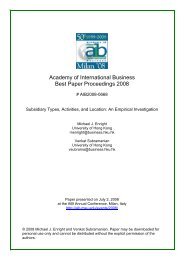AIB 2012 Conference Proceedings - Academy of International ...
AIB 2012 Conference Proceedings - Academy of International ...
AIB 2012 Conference Proceedings - Academy of International ...
Create successful ePaper yourself
Turn your PDF publications into a flip-book with our unique Google optimized e-Paper software.
MONDAY<br />
Exporting and Product Innovation <strong>of</strong> Chinese Firms:The Contingent Role <strong>of</strong> Institutional Development and<br />
Foreign Competitor Intensity<br />
Alex Xin Chen, University <strong>of</strong> Hong Kong<br />
Kevin Zheng Zhou, University <strong>of</strong> Hong Kong<br />
Drawing on organizational learning perspective, we examine the curvilinear relationship between exporting and<br />
product innovation. The results <strong>of</strong> a survey <strong>of</strong> 262 Chinese exporters show that exporting has an inverted U-<br />
shaped relationship with product innovation. That is, a moderate level <strong>of</strong> exporting has the strongest effect on<br />
innovation, whereas a high level <strong>of</strong> exporting is inhibitive to innovation. Moreover, the inverted U-shaped effect<br />
is more prominent when institution environment is better developed and foreign competitor intensity is high.<br />
Our findings provide a more nuanced understanding <strong>of</strong> exporting and suggest a contingent view <strong>of</strong> exporting on<br />
product innovation. (For more information, please contact: Alex Xin Chen, University <strong>of</strong> Hong Kong, Hong Kong,<br />
SAR-PRC: alexchen@hku.hk)<br />
Learning by Trading: Trade Vertical Specialization and <strong>International</strong> Technology Trade<br />
Szu-Wei Yen, WuFeng University<br />
Chun-Chen Huang, Asia University<br />
This paper examines the relationships between trade vertical specialization and the international technology<br />
trade. The OECD proposed using the technology balance <strong>of</strong> payments to measure relationships between the<br />
technology imports and exports <strong>of</strong> a nation. In order to address the problem <strong>of</strong> such an index underestimating<br />
the contribution <strong>of</strong> technology imports to technology exports, this study attempts to construct an empirical<br />
model that measures this by considering the effects <strong>of</strong> interindustry diffusion, in order to estimate more<br />
precisely the level <strong>of</strong> change in industrial technology under international technical trade. Another objective <strong>of</strong><br />
this paper is to measure vertical specialization levels and trends in the manufacturing industry, and to examine<br />
the relationship between international trade in vertical specialization and the contribution <strong>of</strong> technology imports<br />
to technology exports. Using longitudinal data and input–output tables from 1994 to 2002 for Taiwan's<br />
manufacturing industry, the empirical results reveal a strong relationship between international trade with<br />
vertical specialization and the contribution <strong>of</strong> technology imports to technology exports. (For more information,<br />
please contact: Szu-Wei Yen, WuFeng University, Taiwan: sword@wfu.edu.tw)<br />
Session: 2.3.14 - Interactive<br />
Track: 2 - Marketing and Supply Chain<br />
Market Entry, Relationships and Ethics<br />
Presented On: July 2, <strong>2012</strong> - 13:00-14:15<br />
Chair: Hongzhi Gao, Victoria University <strong>of</strong> Wellington<br />
<strong>International</strong> Marketing Channels for Brazilian Beef: Comparison between Russia and the United Kingdom<br />
Karim Marini Thomé, University <strong>of</strong> Brasilia<br />
Luciana Marques Vieira, Unisinos<br />
Antonio Carlos dos Santos, Federal University <strong>of</strong> Lavras<br />
This paper compares international marketing channels for Brazilian beef in two different markets: Russia and<br />
the United Kingdom. The study is a multiple case study with qualitative variables where data were obtained<br />
through semi-structured interviews Brazilian meatpacking and the retailers and distribution agents in the<br />
Russian and British markets. The results show that the model hereby developed allowed to understand the<br />
<strong>AIB</strong> <strong>2012</strong> <strong>Conference</strong> <strong>Proceedings</strong><br />
Page 159

















